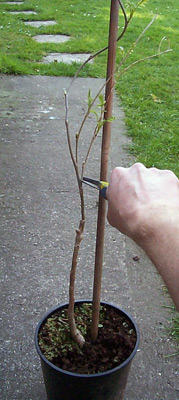Training a Standard Wisteria
Wisterias are fabulous climbers in their own regard, they also lend themselves to training as a large standard.
I like Wisteria and I like some plants that are trained as standards, this is a good way to grow what is normally a climber without having a wall to support it. It is also a good longer term project as they are significantly larger and longer lived than most plants that are commonly trained as standards.
The Victorians sometimes grew standard Wisteria in parks, they can become self-supporting when mature and can have substantial pieces of ironwork amongst the twisted trunks from when they were younger and needed them.
A serendipitous trip to a garden centre meant that I saw a forlorn Wisteria in the "cheap and poorly plants" corner. I wasn't really looking for one, but decided it was time to begin.
To achieve this, I used:
- Young Wisteria plant, a small plant with a single stem is best as you are going to train it yourself quite ruthlessly.
- Multi purpose compost
- 10L or 15L pot, (lesson learned - better to start in the ground in the final position)
- A very strong support for the plant when in the large pot, I didn't use bamboo as I knew this would rot over a couple of years in the soil. As it was, my broom handle support also rotted. There needs to be a clear height from compost/soil level by the ultimate height of the standard plants stem, about 6 feet or more, (lesson learned - use the final substantial metal support from the start)
- Substantial metal support for the tall and heavy plant, used after a couple of years when planting in the final position in the soil.
Step one with standards is a bit nerve racking as it entails cutting off all shoots bar one which is to be the leader and trained up the support - so here goes....



